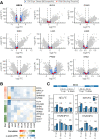Towards resolution of the intron retention paradox in breast cancer
- PMID: 36581993
- PMCID: PMC9798573
- DOI: 10.1186/s13058-022-01593-1
Towards resolution of the intron retention paradox in breast cancer
Abstract
Background: After many years of neglect in the field of alternative splicing, the importance of intron retention (IR) in cancer has come into focus following landmark discoveries of aberrant IR patterns in cancer. Many solid and liquid tumours are associated with drastic increases in IR, and such patterns have been pursued as both biomarkers and therapeutic targets. Paradoxically, breast cancer (BrCa) is the only tumour type in which IR is reduced compared to adjacent normal breast tissue.
Methods: In this study, we have conducted a pan-cancer analysis of IR with emphasis on BrCa and its subtypes. We explored mechanisms that could cause aberrant and pathological IR and clarified why normal breast tissue has unusually high IR.
Results: Strikingly, we found that aberrantly decreasing IR in BrCa can be largely attributed to normal breast tissue having the highest occurrence of IR events compared to other healthy tissues. Our analyses suggest that low numbers of IR events in breast tumours are associated with poor prognosis, particularly in the luminal B subtype. Interestingly, we found that IR frequencies negatively correlate with cell proliferation in BrCa cells, i.e. rapidly dividing tumour cells have the lowest number of IR events. Aberrant RNA-binding protein expression and changes in tissue composition are among the causes of aberrantly decreasing IR in BrCa.
Conclusions: Our results suggest that IR should be considered for therapeutic manipulation in BrCa patients with aberrantly low IR levels and that further work is needed to understand the cause and impact of high IR in other tumour types.
Keywords: Adipocytes; Alternative splicing; Cancer transcriptomics; Luminal B breast cancer; Patient stratification.
© 2022. The Author(s).
Conflict of interest statement
J.E.J.R. has received honoraria or speaker fees (GSK, Miltenyi, Takeda, Gilead, Pfizer, Spark, Novartis, Celgene, bluebird bio); Director of Pathology (Genea); equity ownership (Genea, Rarecyte); consultant (Rarecyte, Imago); and chair, Gene Technology Technical Advisory, OGTR, Australian Government. The remaining authors declare no competing financial interests.
Figures





References
Publication types
MeSH terms
Grants and funding
LinkOut - more resources
Full Text Sources
Medical
Molecular Biology Databases

